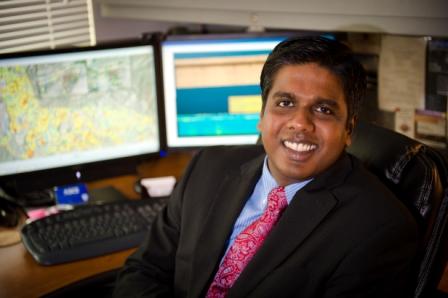Special Guest Lecture: Remote Sensing for Geohazards
The Graduate Civil Engineering Seminar Series will bring Thomas Oommen of Michigan Technological University to the University of Arkansas campus Monday, April 17, for a special lecture on Integrated Remote Sensing Techniques for Geohazard Characterization and Geotechnical Asset Management.
The lecture will take place in the John A. White Jr. Engineering Hall (ENGR) Room 304 from 11:50 a.m. to 12:40 p.m. Light refreshments will be provided.
Abstract: Since the collapse of Mount St. Helens, Washington, in May of 1980, the structural failure of volcanoes has been widely recognized as a pervasive and potentially devastating phenomenon. Considering the logistical challenges of monitoring deformation at an active volcano, remote sensing techniques are particularly advantageous. This is true of Pacaya Volcano in Guatemala, a dominantly basaltic complex that has been continually active since the 1960s. Concerns over the stability of the edifice were investigated using a remote sensing technique known as Interferometric Synthetic Aperture Radar (InSAR) surrounding the 2010 eruption. Interferograms produced using ALOS PALSAR and UAVSAR data reveal that the southwest flank slid 3 meters during this eruptive phase, resulting in the largest measured slope instability witnessed in a single event at a volcano that did not result in a catastrophic landslide.
Another challenging application where remote sensing could provide a viable solution is monitoring the condition of geotechnical assets (e.g. retaining walls, cut slopes, and embankments) along transportation corridors. Current management practices restore the assets after failure, rather than identifying and remediating hazardous conditions before they fail. Displacement and velocity computed using InSAR and photogrammetry for geotechnical assets indicate that the current condition and historic trends can be quantified using remote sensing.
Bio: Oommen's research focuses on developing improved susceptibility characterization and documentation of geo-hazards (e.g. earthquakes, landslides) and spatial modeling of georesources (e.g. mineral deposits) over a range of spatial scales and data types. He has adopted an inter-disciplinary research approach from two main areas, specifically aerial/satellite based remote sensing for obtaining data and artificial intelligence/machine learning based methods for data processing and modeling. Oommen earned his doctoral degree in Geotechnical Engineering from Tufts University. He holds an M.S. degree in Systems Engineering from the University of Alaska Fairbanks and a B.E. degree in Civil Engineering from Bangalore University.
More info about Oommen's research at Michigan Technological University can be found at www.geo.mtu.edu/~toommen.
Topics
Contacts
Sean Salazar,
Civil Engineering
484-821-7918,
ssalazar@uark.edu
Headlines
Four Students Named Goldwater Scholars; Two Earn Udall Honorable Mentions
Four U of A students have received the prestigious Goldwater Scholarship, an award for top students in mathematics, science, and engineering.
Cross-Campus Collaboration Culminates in New Outdoor Geological Installation
Grand opening event to celebrate the new GeoLab installation at the U of A’s Gearhart Hall courtyard is set for May 3. The installation will be open to the public year-round.
First Students to Use Online Degree to Hone Nursing Leadership, Elevate Patient Care
Hanna Baxendale and Wendi Kimbrell will begin coursework in the Doctor of Nursing Practice-Executive Master of Business Administration program offered by the Eleanor Mann School of Nursing and Walton College.
Join the Office for Sustainability on a Final Cruise to Campus
Cruise to Campus Wednesdays have fostered a gathering space for individuals interested in biking to campus. Drop by the Old Main Lawn from 7:30-10 a.m. Wednesday for coffee, something to eat and conversation.
Fay Jones School Student Ambassador Program Gives Voice to Design Students
The student ambassador program at the Fay Jones School of Architecture and Design is built to connect top design students with their school, its alumni, its future students and others inside and outside the school.





